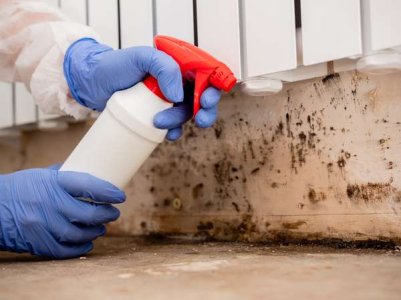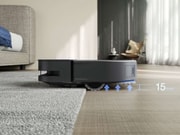Is mould invading your home after the rain? Find out when to expect and how to stop it!
- Replies 2
As the skies finally clear after a period of heavy rainfall and flooding, many Australians are returning to their homes only to find an unwelcome visitor lurking in the corners.
The recent flood in Sydney and other parts of New South Wales and Queensland has left homeowners grappling with the aftermath
Esther Mitchelson spent over $100 on moisture absorbers to combat the dampness that has invaded her living space.
However, her experience is not unique.
After the intense weather conditions, many residents are facing the same battle.

Within just 48 hours of hanging moisture absorbers, Esther found them half-full, a clear sign of the high humidity levels in her home.
‘[The] weather from Thursday to Sunday was like nothing I had seen before.The amount of rain was something else,’ she remarked.
Despite no visible leaks, a strong damp smell from her garage raised concerns about water seepage, and with a history of mould issues, the situation has become particularly stressful, especially with children allergic to spores in the household.
‘[It's] so stressful. I'm just “Damprid-ing”, and hoping to make it through winter,’ Esther lamented.
Following four days of heavy rainfall and flooding, individuals such as Esther are worried about the potential growth of mould.
With the subsiding of the severe weather, the NSW State Emergency Service advised residents to return home cautiously, as they may encounter an unwelcome visitor.
Experts emphasised that the indoor mould risk increased; however, there are specific indicators to be mindful of.
Understanding mould growth post-rainfall
The recent weather events created the perfect storm for mould proliferation.
Dr Heike Neumeister-Kemp from Mycolab, Australia's only laboratory for environmental mycology, has been overwhelmed with calls for help.
High humidity and spore loads in the air meant that ‘things have gotten mouldy that hadn't been mouldy before’.
‘Many apartments and partially houses are experiencing condensation issues... because of lack of ventilation and humidity that comes into the dwellings and then condensates,’ Dr Neumeister-Kemp explained.
‘Right now in [NSW], it's not just a condensation issue because you literally had “rain bombs” dropping, and often the houses aren't built for that extreme amount of water.’
She further noted that substantial rainfall amounts could lead to gutter overflow, while strong winds may drive moisture beneath flooring.
Rebecca Bentley, Director of the Centre for Research Excellence in Healthy Housing, echoed Dr Neumeister-Kemp’s point, saying that rain and flooding create ideal conditions for mould.
‘If you have a home where you've got water coming in and sitting on surfaces, and the right temperatures, it will grow... particularly if you've got a house that's locked up or that has fairly poor ventilation,’ she expounded.
‘There's no hard-or-fast rule, [but] houses that say [they] don't have a lot of natural light, have poor ventilation, have a lot of structural concerns... are much more likely to have major problems.’
Identifying the types of mould in your home
Dr Neumeister-Kemp mentioned that among the prevalent types of mould, present both indoors and in outdoor air, is a variety stemming from the Cladosporium family, characterised by hues of green and brown along with white speckles.
‘Now of course, if Cladosporium was already present in the air, there's a likelihood that [that] particular family lands on a surface... that is very, very wet,’ she pointed out.
‘If the surface then starts to dry up, and is what we say, moderately moist, then we have a family from the group Aspergillus and Penicillium that normally takes over.’
She said it is similar to the fuzzy green mould typically encountered on wood or spoiled food.
‘Then, many different types of fungi start to grow on different building materials simply because they have different nutrient requirements,’ Dr Neumeister-Kemp continued.
For instance, according to her, a skirting board might harbour Chaetomium, which thrives on deteriorating wood fibres.
However, if the mould persists for an extended period, she speculated that it's more likely to be Trichoderma, particularly on construction materials.
‘We can actually pinpoint from what type of mould it is, how wet [the house] has been and what type of substrate is there,’ Dr Dr Neumeister-Kemp added.
Keeping an eye on the signs of mould
Professor Bentley advised being vigilant for evident indications of mould, such as damp patches on plasterboard, walls, and carpets, or the initial appearance of spores.
‘The other thing is that smell, some moulds do create an odour, and the damp can certainly create an odour as well,’ she said.
She suggested that surveying your residence to pinpoint potential locations for mould growth could also be beneficial—such as gutters, seals around entry points like windows, or areas where water could infiltrate beneath or around the house.
‘When [water] gets into the house it can travel down walls and into floors,’ Professor Bentley explained.
‘It doesn't have to be that it's sort of sitting somewhere you can see it, water can travel down cavities or you can get condensation or water building up in walls, and that can create more problems that are a bit harder to detect because you can't see them.’
Timing the appearance of mould
Professor Bentley noted that if your property has a history of mould, it's likely to resurface following a period of wet weather.
Although mould can sometimes become visible overnight, Dr Neumeister-Kemp clarified that the initial stages of the process can begin in less than thirty minutes.
‘Mould actually starts to grow within 20 minutes... [but] the thing is, to the naked eye, the mould only becomes apparent after four to six days,’ Dr Neumeister-Kemp said.
‘So people only see it quite a few days after unless they really go looking for it.’
She also advised that the most effective method to detect mould beforehand is to use an LED torch and illuminate surfaces at an angle.
‘A lot of mould is not visible to the naked eye, so just because you can't see anything on the furniture, you can still have a high amount in the air or it can be hidden,’ she continued.
Furthermore, according to Dr Neumeister-Kemp, weather conditions can also be a contributing factor.
‘When it is super hot of course the mould thrives, but the problem is, when it's cold, the mould doesn't thrive so much but the condensation increases,’ she explained.
‘There's many mould species that actually love colder climates and grow perfectly fine between five to 25 C.’
‘If we now have all this excess moisture because it's cold, that is something that needs to be addressed,’ she added.
Preparing for the future
Professor Bentley suggested that maintaining adequate airflow and ensuring the internal temperature of a property remains between approximately 18 to 22 degrees Celsius could aid in preventing mould from adhering to surfaces throughout the property.
Dr Neumeister-Kemp concurred, stating that ceiling fans, along with open windows and doors fitted with screens, can aid in ventilation.
‘Only open the window after morning dew, actually monitor what the relative humidity is, and then you need to close the windows before the afternoon dew comes in and the relative humidity increases,’ she said.
However, Professor Bentley reassured that despite people's diligent efforts to prevent mould, it could still occur regardless.
‘So from the owner's point of view, what you can do is fix things as soon as you find them and be vigilant for structural problems, Professor Bentley advised.
But for everyday prevention, she suggested practices such as avoiding storing damp or wet clothes in closets, opting to hang laundry outside when feasible, and routinely inspecting furniture placed against walls for signs of mould.
Tackling household mould effectively
Individuals who possess a bagged vacuum cleaner equipped with a high-efficiency particulate absorbing (HEPA) filter might consider initially using the suction device on the mould, as it will capture the spores, suggested Dr Neumeister-Kemp.
‘If you're really advanced, you can have a horsehair brush attachment on the vacuum because the plastic brush will just flick [mould] around, but a horsehair brush is electrostatic and absorbs it,’ she recommended.
She also advised using diluted household vinegar and a microfibre cloth to clean small areas of mould. Alternatively, thinned-down methylated spirits can also be effective.
On the other hand, other cleaning experts recommended using bicarb soda or using this affordable supermarket product.
Despite common belief, mould cannot be killed with chemicals due to its triple-membrane structure.
‘So if you put bleach on mould, it takes the colour, but the mould is still there,’ she said, suggesting methods involving ‘physical attack’, such as using commercial plant-based products extracted from essential oils.
Professor Bentley advocated for cleaning up mould while wearing personal protective equipment, such as masks and gloves, and ensuring that the area is well-ventilated.
‘I think the trick with cleaning mould is that you want to obviously remove it from the surface in a way that it's not going to grow back,’ she stated.
‘But you also just want to be careful yourself when dealing with it, that you're not inhaling it or disturbing it in the way of spreading spores through the house.’
NSW Health recommended ensuring the surface is thoroughly dried after cleaning, and suggested that absorbent materials like carpet may require professional cleaning or replacement if contaminated.
Professor Bentley also noted that Australians should anticipate the possibility of increased mould presence in their homes in the future.
‘I think finally, with a changing climate, we're probably going to see more storms and floods, so we're going to have to deal with this more often,’ she added.
With experts warning of heightened risks due to the recent weather conditions, many are seeking advice on how to effectively tackle this issue.
However, as people attempt to address mould problems, there's a growing realisation that some common cleaning methods might inadvertently worsen the situation.
This revelation prompted discussions about the importance of understanding proper cleaning techniques to prevent inadvertently making the mould problem worse.

Have you battled mould in your home after heavy rain? What strategies have you found most effective in keeping your living space mould-free? Share your experiences with us in the comments below.
The recent flood in Sydney and other parts of New South Wales and Queensland has left homeowners grappling with the aftermath
Esther Mitchelson spent over $100 on moisture absorbers to combat the dampness that has invaded her living space.
However, her experience is not unique.
After the intense weather conditions, many residents are facing the same battle.

Heavy rainfall and flooding in NSW and Queensland raised the risk of home mould growth. Credits: Shutterstock
Within just 48 hours of hanging moisture absorbers, Esther found them half-full, a clear sign of the high humidity levels in her home.
‘[The] weather from Thursday to Sunday was like nothing I had seen before.The amount of rain was something else,’ she remarked.
Despite no visible leaks, a strong damp smell from her garage raised concerns about water seepage, and with a history of mould issues, the situation has become particularly stressful, especially with children allergic to spores in the household.
‘[It's] so stressful. I'm just “Damprid-ing”, and hoping to make it through winter,’ Esther lamented.
Following four days of heavy rainfall and flooding, individuals such as Esther are worried about the potential growth of mould.
With the subsiding of the severe weather, the NSW State Emergency Service advised residents to return home cautiously, as they may encounter an unwelcome visitor.
Experts emphasised that the indoor mould risk increased; however, there are specific indicators to be mindful of.
Understanding mould growth post-rainfall
The recent weather events created the perfect storm for mould proliferation.
Dr Heike Neumeister-Kemp from Mycolab, Australia's only laboratory for environmental mycology, has been overwhelmed with calls for help.
High humidity and spore loads in the air meant that ‘things have gotten mouldy that hadn't been mouldy before’.
‘Many apartments and partially houses are experiencing condensation issues... because of lack of ventilation and humidity that comes into the dwellings and then condensates,’ Dr Neumeister-Kemp explained.
‘Right now in [NSW], it's not just a condensation issue because you literally had “rain bombs” dropping, and often the houses aren't built for that extreme amount of water.’
She further noted that substantial rainfall amounts could lead to gutter overflow, while strong winds may drive moisture beneath flooring.
Rebecca Bentley, Director of the Centre for Research Excellence in Healthy Housing, echoed Dr Neumeister-Kemp’s point, saying that rain and flooding create ideal conditions for mould.
‘If you have a home where you've got water coming in and sitting on surfaces, and the right temperatures, it will grow... particularly if you've got a house that's locked up or that has fairly poor ventilation,’ she expounded.
‘There's no hard-or-fast rule, [but] houses that say [they] don't have a lot of natural light, have poor ventilation, have a lot of structural concerns... are much more likely to have major problems.’
Identifying the types of mould in your home
Dr Neumeister-Kemp mentioned that among the prevalent types of mould, present both indoors and in outdoor air, is a variety stemming from the Cladosporium family, characterised by hues of green and brown along with white speckles.
‘Now of course, if Cladosporium was already present in the air, there's a likelihood that [that] particular family lands on a surface... that is very, very wet,’ she pointed out.
‘If the surface then starts to dry up, and is what we say, moderately moist, then we have a family from the group Aspergillus and Penicillium that normally takes over.’
She said it is similar to the fuzzy green mould typically encountered on wood or spoiled food.
‘Then, many different types of fungi start to grow on different building materials simply because they have different nutrient requirements,’ Dr Neumeister-Kemp continued.
For instance, according to her, a skirting board might harbour Chaetomium, which thrives on deteriorating wood fibres.
However, if the mould persists for an extended period, she speculated that it's more likely to be Trichoderma, particularly on construction materials.
‘We can actually pinpoint from what type of mould it is, how wet [the house] has been and what type of substrate is there,’ Dr Dr Neumeister-Kemp added.
Keeping an eye on the signs of mould
Professor Bentley advised being vigilant for evident indications of mould, such as damp patches on plasterboard, walls, and carpets, or the initial appearance of spores.
‘The other thing is that smell, some moulds do create an odour, and the damp can certainly create an odour as well,’ she said.
She suggested that surveying your residence to pinpoint potential locations for mould growth could also be beneficial—such as gutters, seals around entry points like windows, or areas where water could infiltrate beneath or around the house.
‘When [water] gets into the house it can travel down walls and into floors,’ Professor Bentley explained.
‘It doesn't have to be that it's sort of sitting somewhere you can see it, water can travel down cavities or you can get condensation or water building up in walls, and that can create more problems that are a bit harder to detect because you can't see them.’
Timing the appearance of mould
Professor Bentley noted that if your property has a history of mould, it's likely to resurface following a period of wet weather.
Although mould can sometimes become visible overnight, Dr Neumeister-Kemp clarified that the initial stages of the process can begin in less than thirty minutes.
‘Mould actually starts to grow within 20 minutes... [but] the thing is, to the naked eye, the mould only becomes apparent after four to six days,’ Dr Neumeister-Kemp said.
‘So people only see it quite a few days after unless they really go looking for it.’
She also advised that the most effective method to detect mould beforehand is to use an LED torch and illuminate surfaces at an angle.
‘A lot of mould is not visible to the naked eye, so just because you can't see anything on the furniture, you can still have a high amount in the air or it can be hidden,’ she continued.
Furthermore, according to Dr Neumeister-Kemp, weather conditions can also be a contributing factor.
‘When it is super hot of course the mould thrives, but the problem is, when it's cold, the mould doesn't thrive so much but the condensation increases,’ she explained.
‘There's many mould species that actually love colder climates and grow perfectly fine between five to 25 C.’
‘If we now have all this excess moisture because it's cold, that is something that needs to be addressed,’ she added.
Preparing for the future
Professor Bentley suggested that maintaining adequate airflow and ensuring the internal temperature of a property remains between approximately 18 to 22 degrees Celsius could aid in preventing mould from adhering to surfaces throughout the property.
Dr Neumeister-Kemp concurred, stating that ceiling fans, along with open windows and doors fitted with screens, can aid in ventilation.
‘Only open the window after morning dew, actually monitor what the relative humidity is, and then you need to close the windows before the afternoon dew comes in and the relative humidity increases,’ she said.
However, Professor Bentley reassured that despite people's diligent efforts to prevent mould, it could still occur regardless.
‘So from the owner's point of view, what you can do is fix things as soon as you find them and be vigilant for structural problems, Professor Bentley advised.
But for everyday prevention, she suggested practices such as avoiding storing damp or wet clothes in closets, opting to hang laundry outside when feasible, and routinely inspecting furniture placed against walls for signs of mould.
Tackling household mould effectively
Individuals who possess a bagged vacuum cleaner equipped with a high-efficiency particulate absorbing (HEPA) filter might consider initially using the suction device on the mould, as it will capture the spores, suggested Dr Neumeister-Kemp.
‘If you're really advanced, you can have a horsehair brush attachment on the vacuum because the plastic brush will just flick [mould] around, but a horsehair brush is electrostatic and absorbs it,’ she recommended.
She also advised using diluted household vinegar and a microfibre cloth to clean small areas of mould. Alternatively, thinned-down methylated spirits can also be effective.
On the other hand, other cleaning experts recommended using bicarb soda or using this affordable supermarket product.
Despite common belief, mould cannot be killed with chemicals due to its triple-membrane structure.
‘So if you put bleach on mould, it takes the colour, but the mould is still there,’ she said, suggesting methods involving ‘physical attack’, such as using commercial plant-based products extracted from essential oils.
Professor Bentley advocated for cleaning up mould while wearing personal protective equipment, such as masks and gloves, and ensuring that the area is well-ventilated.
‘I think the trick with cleaning mould is that you want to obviously remove it from the surface in a way that it's not going to grow back,’ she stated.
‘But you also just want to be careful yourself when dealing with it, that you're not inhaling it or disturbing it in the way of spreading spores through the house.’
NSW Health recommended ensuring the surface is thoroughly dried after cleaning, and suggested that absorbent materials like carpet may require professional cleaning or replacement if contaminated.
Professor Bentley also noted that Australians should anticipate the possibility of increased mould presence in their homes in the future.
‘I think finally, with a changing climate, we're probably going to see more storms and floods, so we're going to have to deal with this more often,’ she added.
With experts warning of heightened risks due to the recent weather conditions, many are seeking advice on how to effectively tackle this issue.
However, as people attempt to address mould problems, there's a growing realisation that some common cleaning methods might inadvertently worsen the situation.
This revelation prompted discussions about the importance of understanding proper cleaning techniques to prevent inadvertently making the mould problem worse.
Key Takeaways
- Heavy rainfall and flooding in NSW and Queensland heightened the risk of mould growth in homes, with concerns especially for those with previous mould issues.
- Mould growth can begin within 20 minutes in the right conditions, but may not be visible to the naked eye until days later. LED torches angled at surfaces can help detect mould early on.
- To prevent mould, maintaining good airflow, monitoring humidity, and keeping indoor temperatures between 18 to 22 degrees Celsius are recommended. Removing moisture promptly and ensuring proper ventilation are key strategies.
- Tackling household mould should be done with personal protective equipment and appropriate cleaning methods. Bleach is not effective at killing mould due to its triple-membrane structure; physical removal is necessary, and affected absorbent materials may need professional cleaning or replacement.







